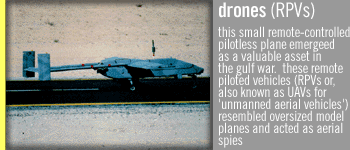



 The US Navy, Marine Corps, and Army used basically two types of RPVs in the
war,the Pointer and the more sophisticated Pioneer.
The US Navy, Marine Corps, and Army used basically two types of RPVs in the
war,the Pointer and the more sophisticated Pioneer.
The Pioneer drone (developed by the Israelis and produced in the U.S.) has a
wingspan of 17 feet and is 14 feet long. It is powered by a 26 horsepower
snowmobile engine and has a range of about 100 miles and a flight duration of
five hours. It can carry a multitude of sensors including television and FLIR.
The drone is catapulted into the air and while airborne runs on liquid fuel. It
is guided by an electronic box with a joystick that the operator uses to turn the
plane left or right, up or down in the same way remote-controlled model planes
work. Each Pioneer costs about $500,000 and carries a $400,000 video camera that
can take highly-detailed pictures from 2,000 feet and transmit them 100 miles
away.


According to a May 1991 Department of the Navy report, "At least one UAV was
airborne at all times during Desert Storm."
There were 522 sorties/1641 hours flown -- with the Navy having 100 sorties; the
Marine Corps 94; the Army 48. RPVs were used extensively in Desert Shield and
Desert Storm, not only by the United States but also by coalition forces.
In its use as long distance eyes for battleship guns, the RPV's position was sent
to the shipboard computer. Based on that information, the shipboard artillery
aimed at whatever the RPV 'sees.' The RPVs's were also used by Marines for
aerial patrols along the Saudi-Kuwait border. The camera's infrared capacity
picked up troops on the ground and vehicles hidden behind camouflage. It picked
out targets for bombing runs by B-52s or F-15s. When bombing raids are over, it
circled over the area and sent back live tv coverage of the damage done. RPVs
were also used to collect mapping information to steer Tomahawk cruise missiles
to their targets.
"During the last week of the Gulf War, thousands of Iraqis
surrendered......One of the most unusual surrenders took place when a Pioneer remotely-piloted vehicle
droned above the battlefield, surveying potential targets. Five Iraqi soldiers
waved white flags at its tiny television camera. it was the first time in
history that men surrendered to a robot."
From: James Coyne, "Air Power in the Gulf"


"The Pioneer unmanned aerial vehicle (UAV) provided substantial imagery support
to Marine, Army and Navy units during Operation Desert Storm. They were so good
many more could have been used.
These systems were employed for battlefield damage assesment (BDA), targeting
(e.g., adjusting the accuracy of the battleships' 16-inch guns, which were
used extensively against Iraqi fortifications along the Kuwaiti coastline) and
surveillance missions, particularly in high-threat airspace.
The intelligence officer for a Marine Division which was blessed with more UAVs
than any other unit in-theater commented, UAVs were great for target validation
and BDA, but we could have used three times as many as we had. The Army took its
solitary set of UAVs into the war and is now looking for many more. In one
instance, Iraqi troops actually attempted to surrender to a UAV loitering over
their position."
From: "Intelligence Successes and Failures in Operations
Desert Shield/Stormž--Report of the Oversight and Investigations Subcommittee, Committee
on Armed Services, U.S. House of Representatives, August, 1993.

home · oral history · war stories · weapons · maps · chronology
tapes & transcripts
FRONTLINE · wgbh · pbs online
web site copyright WGBH educational foundation
 |